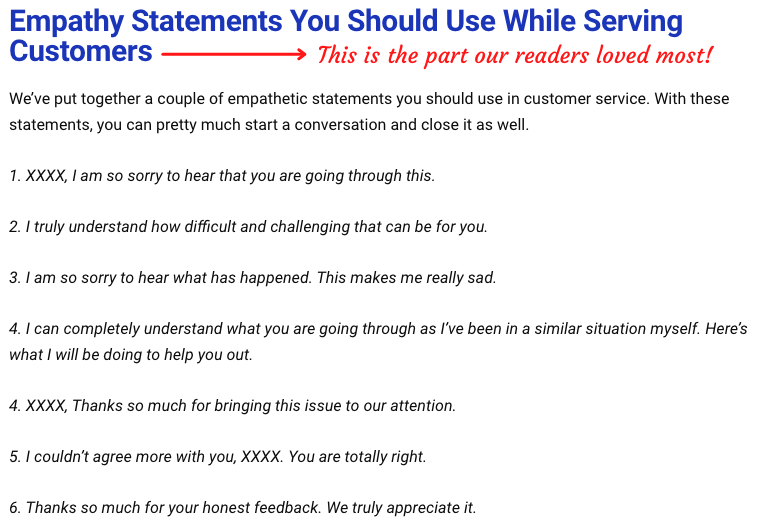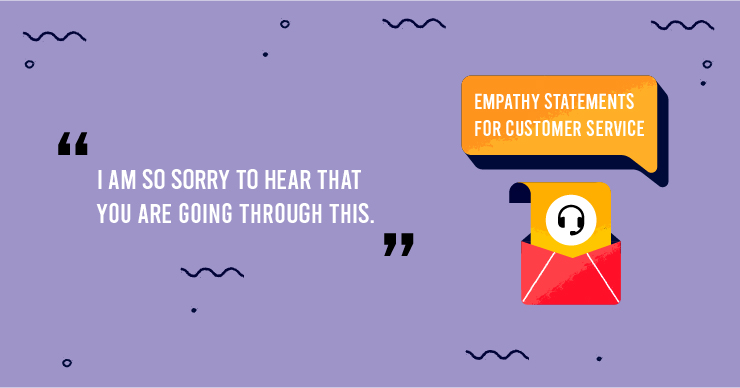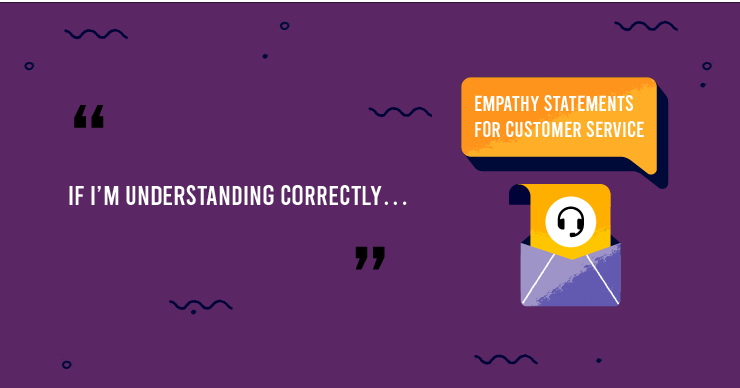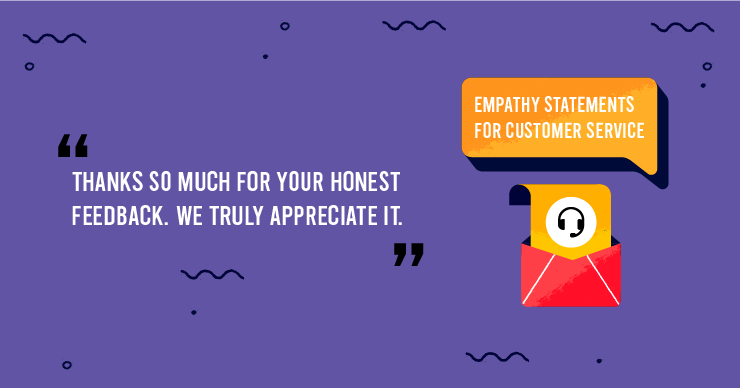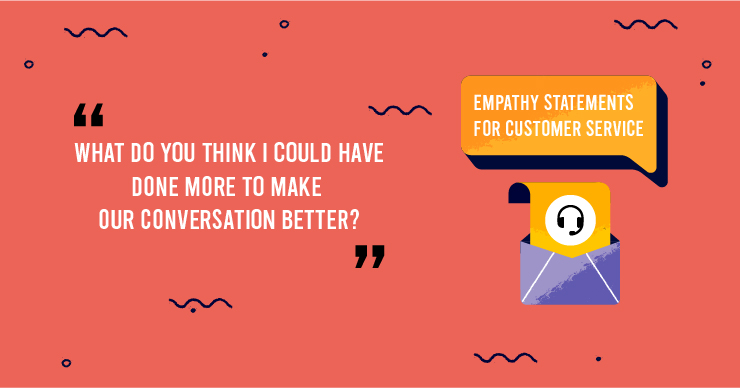We’ll quickly tell you the reason why we decided to come up with this article on empathy statements for customer service.
When we sent an email about our recent guide (empathy in customer service), we received quite a number of responses – “a lot” would be the appropriate word. Our subscribers just loved the guide, especially the empathy statements part.
We were even asked if we could come up with a separate article on this. We were like, “Okay sure. Why not?” And here we are!
So, that’s the story behind how we came up with this blog. Here, we’ve put together a couple of best empathy statements for customer service and the reason behind why they work well.
Before we get there, here’s the link to our guide in case you haven’t read it yet – Everything You Need to Know About Empathy In Customer Service.
We’ve discussed a great deal about what is empathy in customer service, why it is important and the ways you can practice empathy with your customers.
That said, let’s move on to the read.
What are Empathy Statements in Customer Service?
Empathy statements are phrases used by customer support agents to establish a connection with the customer. When used, it shows the customer that you care for them and that you work for them to resolve the issue.

This improves communication, resulting in a better understanding of the situation, quick resolutions when possible and great customer experiences.
In short, here’s an emoji that explains empathy statements – 🤗
Also, using empathy statements in customer support comes with its benefits – increase in sales & conversions, improved agent productivity and most importantly, better customer satisfaction rates leading to a loyal customer base.
Like we said, we’ve explained it all in our empathy in customer service guide!
15 Empathy Statements You Should Be Using
Using empathy statements in customer service can elevate your brand reputation as a whole. A support agent will have to deal with different kinds of scenarios every day. They might have to apologize, acknowledge, thank the customer and even ask for feedback from them.
When all these situations are dealt with empathy, the trust factor automatically comes in and the customer-brand relationship gets stronger.
That said, we’ll look at the empathy statements you should use in customer service.
Empathy Statements to Acknowledge Customer Frustration
The first step when dealing with a customer who is possibly frustrated or facing an issue is to acknowledge them. Frustrated customers want to be heard and understood. The solution part comes later. Here are examples of empathy statements that’ll help you to acknowledge your customers’ frustration.
1. I am so sorry to hear that you are going through this.
This empathy statement is like straight off the bat. When you say sorry to customers for what they are going through, a strong sense of empathy is displayed.
The customer immediately becomes less frustrated and starts explaining the issue in a more calm and settled tone.
2. I truly understand how difficult and challenging that can be for you.
Understanding your customers’ pain points is the key to resolving their issues. Showing your customers that you understand their difficulties diffuses the situation. The above statement will let your customer know that you’ve acknowledged and understood their issue, giving them a sense of confidence that they are talking with the right person.
3. I am so sorry to hear what has happened. This makes me really sad.
There’s a difference between “I feel for you” and “I feel with you” – sympathy and empathy.
When you empathize with your customers’ feelings, it is a clear sign that you understand and acknowledge their concerns. Customers will strongly believe that you’ll be able to find a suitable solution for them.
Empathy Statements to Stay on the Same Page With Customers
When dealing with customers, it’s important that you stay on the same page and resonate with them. This requires you to practice active listening – listen to what your customers are saying will full attention. Show them you are listening by acknowledging it with empathetic statements.
4. I can understand what you are going through as I’ve been in a similar situation myself.
This is an effective empathy statement that shows customers you are listening to them. The customer knows that you’ve made an effort by putting yourself in their shoes. An instant connection will be established with the customer which will help you in solving the issue more efficiently.
5. If I’m understanding correctly…
The best way to ensure that you and your customer are on the same page is by repeating what they just shared with you – at least the problem part.
There’s nothing more frustrating than dealing with a support agent who has misunderstood the issue. The customer has to repeat themselves which is the last thing they’d want to do at this time. It’s always a good idea to check the facts once again and even ask if there’s anything that’s not clear to you.
6. XXX, I’ve experienced this issue myself. I am so sorry to hear this.
This is more like the 4th empathy statement we saw but just in a different variation. At times, you can relate yourself to the customer through incidents that you have faced. Revealing the same can change the tone of the customer. They might even empathize with you.
You can share your experiences with the customer as to how you dealt with the issue – helps with the bonding and you can proceed to resolve the issue.
P.S. The XXX is a placeholder for the name.
Empathetic Statements to Reassure Your Customers
Reassuring your customers gives them instant relief. And when you induce empathy, it’s a powerful combination that works almost every time.
Here are some examples.
7. I assure you that I’ll do everything possible from my side to fix this.
You’re not making a promise here. But you’re assuring the customer that you’re going to do everything possible to resolve the issue.
Such statements create a major impact on your customers. They end up appreciating your commitment. And yes. Make sure you mean it when you say it!
8. Thanks so much for your patience. Here’s how I can…
When your customer is waiting for a minute or two, it’s always a good idea to thank them for waiting. Considering the distress situation they are in, this should diffuse the situation to a certain degree.
When you also state how you’re going to deal with the situation, your customers are going to be pretty much satisfied.
You’ll most likely use this statement in between the conversation – when you ask your customer to hold while you look more into the issue.
9. I can assure you that the issue you are facing will be completely solved in X business days.
This one is similar to the 7th statement. But here, you’re coming up with a timeline as to when the issue will be fixed. Setting up a timeline and resolving the issue as said boost the trust factor to a great extent.
As for customers, they’ll be more satisfied when you give them a definite timeline. You can also say that you’ll keep them posted – you’re indirectly saying your customer not to worry about the issue and you’re there to take care of it.
Works right every time.
10. I couldn’t agree more with you, XXXX. You are right.
As a support agent, your job is to help your customers. At times, your business could be at fault and you should not hesitate to empathize with your customers and take their side.
Customers start trusting you more when you are transparent. When you empathize and agree with your customers, they feel like they’ve won the battle – you just have to make it easier for them.
Empathy Statements to Thank and Appreciate Your Customers
Customers don’t generally share their feedback or opinion with businesses. It’s because they feel that they won’t be taken seriously or even appreciated in the first place. But when a customer does so, as a support agent, it’s your responsibility to thank them for it.
This improves the relationship between the customer and your business. Down the lane, they might even become a loyal customer.
11. Thanks so much for your honest feedback. We truly appreciate it.
When your customer shares feedback (doesn’t matter whether it’s useful or not), thank them genuinely by using statements filled with gratitude words.
It’s all about making your customer feel happy so that they’ll come back for more and stay loyal.
12. Your feedback means a lot to us. It will help us grow. Thank you so much.
Accepting customer feedback and considering them is a sign that your business has a positive growth culture. Customers are the king and taking into account their feedback helps your business grow exponentially.
Thank your customer for spending the time to share their feedback with you and also mention that it means a lot for your business.
Statements to Receive Feedback – The Wrap Up
A good customer support agent encourages the customer to ask more questions and come back anytime. This makes the customer believe that they can rely on the support team when they want. Asking them how they felt at the end of a support interaction encourages them and increases the trust factor.
13. What do you think I could have done more to make our conversation better?
This statement means you’re looking for opportunities to improve yourself as a support agent. And your customers love that!
Ask them what could have made the support interaction better. If your customer comes with feedback, note them down. This might even be the start of a new practice within your customer service department.
Using such statements make your customer feel important and inclusive.
14. Is there anything else you’d like to know or I can help you with?
While wrapping up a conversation, treat the above statement like an unsaid rule. Offering your customer more time and effort directly reflects your customer service culture. Your customer understands that you’re willing to go above and beyond to help them out. This also gives the customer a chance to clarify all their issues – increases customer happiness.
15. Create Your Own Empathy Statements
Yes. That’s right! You cannot go by the playbook every time. You have to come up with empathy statements of your own.
If you think it’s difficult, IT’S NOT! Once you understand what is empathy and how it can deeply influence your customer service, you‘ll naturally start to empathize with your customers. There, it’s sorted!
Just make sure to remember this – you have to establish a connection with your customers and put yourself in their shoes.
Sample Conversation With Empathy Statements
So far, we came across empathy statements you should use for different customer service scenarios. We thought why not come up with a sample conversation and show you what it looks like when empathy statements are used.
Agent John: Hello Mike! This is John. Hope you are doing good. How can I help you today?
Mike: Hi John. My delivery is taking longer than usual. I was supposed to get it a day ago.
Agent John: I am so sorry to hear what happened. This makes me really sad. Can I put you on hold while I check the status of your delivery?
Mike: Sure.
Agent John: Thanks so much for your patience. There’s been a delay in the delivery due to [reason]. I can assure you that you’ll be receiving your product in 2 business days. I am so sorry you have to go through this.
Mike: Okay. Thanks so much.
Agent John: Is there anything else you’d like to know or I can help you with?
Mike: No John. That’s pretty much it. Thanks so much.
Agent John. Thank you Mike. Have a nice day!
Now that’s a wholesome support conversation. Pretty sure that Mike would have had a great experience. Most of the sentences used by John were empathy statements we just listed above. Similarly, make sure that you and your support team use them while serving your customers as well!
So, the above-mentioned are the empathy statements for customer service we were talking about.
Dealing with difficult customers can be tough. You cannot come up with an effective solution every time. But when you empathize with them, the entire support interaction gets much easier and could be the starting point for a long-term relationship between the customer and the brand.
Now that you’ve got what you were looking for, it’s time you start using them. Start creating better customer experiences with empathy statements.
Let us know in the comments if you have any empathy statements you’d like to share with us!

